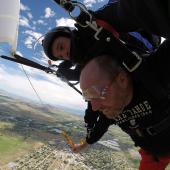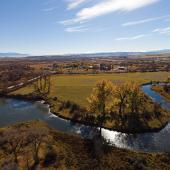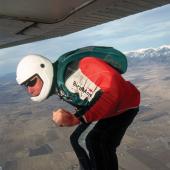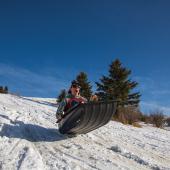History of Parachuting
Starting with the first person that thought jumping off of high objects was a good idea.
Skydiving has come a long way since Leonardo da Vinci sketched the earliest known rendition of a parachute in 1495. Da Vinci’s conception was a pyramid-shaped, cloth-covered contraption that really worked; it took more than a century to make the leap from the artist’s drawing to the real thing, but in 1617 a man named Fauste Veranzio jumped from a tower in Venice, Italy, utilizing a chute similar to da Vinci’s.
By 1783, hot air balloonists Joseph and Jacques Montgolfier were sending animals on parachute rides. Two years later, the first escape from an aircraft in distress was made via parachute, when Pierre Blanchard parachuted safely from an exploding hot air balloon. Blanchard also invented the pyramid-free silk parachute; the first one was used in 1797.
Skydiving would suffer its first fatality, that of one Robert Cocking, in 1837; but the “sport” hung on, and continued to evolve. The parachute harness was invented in 1887, and three years later parachutes were being packed into knapsacks for convenience and ease of deployment. A “limp” parachute appeared on the scene; no poles held the chute open, and instead of the traditional basket, the limp chute featured a trapeze bar. American Tom Baldwin made the first limp parachute jump in 1897.
The first parachute jumps from an airplane were made by Grant Morton and Albert Berry in 1911 and 1912. Morton used a chute he held in his arms as he leaped; Berry’s chute was packed in a metal box complete with a bar for the skydiver to hold on to.
The American armed forces began to take an interest in parachuting, but in 1914 the military discounted the first free-fall parachute jump, by Georgina Broadwick, instead deciding that a person would black out during the descent. By 1919, however, Leslie Irvin convinced the military otherwise; Irvin made his international free-fall debut in Dayton, Ohio, using a chute of his own design that would revolutionize the brave new world of skydiving.
The military began experimenting with parachutes in World War I, but by the end of World War II, parachutes and paratroopers were a solid part of the military equation. Food, supplies, trucks, and tanks could all be air-dropped with relative ease. Parachutes enabled pilots to survive sure death if their aircraft were shot down or disabled.
Sport parachuting started to take shape between the world wars. Early skydivers took advantage of used military parachuting equipment, adding their own innovations, such as cutting holes in the chute for easier steering and more control. By the ‘50s parachuting gained official aeronautical sport status from the World Air Sports Federation; the first competition took place in Yugoslavia in 1951.
Competition led to the development of high-tech parachutes. The parafoil made its appearance in the 1960s, giving way to the parawing chute by the ‘70s, when sport parachutists, like skiers and others, began to experiment with the “freestyle” aspect of skydiving. A semi-elliptical, “true wing” design became the norm, and today’s skydivers can even land at 20-30 miles per hour, after charting their own path through the sky with a precision that would make da Vinci smile.












